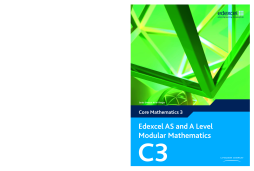
Additional Information
Book Details
Abstract
Edexcel and A Level Modular Mathematics C3 features:
- Student-friendly worked examples and solutions, leading up to a wealth of practice questions.
- Sample exam papers for thorough exam preparation.
- Regular review sections consolidate learning.
- Opportunities for stretch and challenge presented throughout the course.
- ‘Escalator section’ to step up from GCSE.
PLUS Free LiveText CD-ROM, containing Solutionbank and Exam Café to support, motivate and inspire students to reach their potential for exam success.
- Solutionbank contains fully worked solutions with hints and tips for every question in the Student Books.
- Exam Café includes a revision planner and checklist as well as a fully worked examination-style paper with examiner commentary.
Table of Contents
| Section Title | Page | Action | Price |
|---|---|---|---|
| Cover | Cover | ||
| Contents | ii | ||
| About this book | iv | ||
| Chapter 1: Algebraic fractions | 1 | ||
| 1.1: Simplify algebraic fractions by cancelling common factors | 2 | ||
| 1.2: Multiplying and dividing algebraic fractions | 4 | ||
| 1.3: Adding and subtracting algebraic fractions | 6 | ||
| 1.4: Dividing algebraic fractions and the remainder theorem | 8 | ||
| Summary of key points | 11 | ||
| Chapter 2: Functions | 12 | ||
| 2.1: Mapping diagrams and graphs of operations | 13 | ||
| 2.2: Functions and function notation | 14 | ||
| 2.3: Range, mapping diagrams, graphs and definitions of functions | 17 | ||
| 2.4: Using composite functions | 20 | ||
| 2.5: Finding and using inverse functions | 23 | ||
| Summary of key points | 30 | ||
| Chapter 3: The exponential and log functions | 31 | ||
| 3.1: Introducing exponential functions of the form y=ax | 32 | ||
| 3.2: Graphs of exponential functions and modelling using y=ex | 33 | ||
| 3.3: Using ex and the inverse of the exponential function logex | 36 | ||
| Summary of key points | 44 | ||
| Chapter 4: Numerical methods | 45 | ||
| 4.1: Finding approximate roots of f(x)=0 graphically | 46 | ||
| 4.2: Using iterative and algebraic methods to find approximate roots of f(x)=0 | 50 | ||
| Summary of key points | 57 | ||
| Review Exercise 1 | 58 | ||
| Chapter 5: Transforming graphs of functions | 63 | ||
| 5.1: Sketching graphs of the modulus function y=|f(x)| | 64 | ||
| 5.2: Sketching graphs of the function y=f(|x|) | 67 | ||
| 5.3: Solving equations involving a modulus | 69 | ||
| 5.4: Applying a combination of transformations to sketch curves | 72 | ||
| 5.5: Sketching transformations and labelling the coordinates of given point | 77 | ||
| Summary of key points | 82 | ||
| Chapter 6: Trigonometry | 83 | ||
| 6.1: The functions secant ϴ, cosecant ϴ, and cotangent ϴ | 84 | ||
| 6.2: The graphs of secant ϴ, cosecant ϴ, and cotangent ϴ | 87 | ||
| 6.3: Simplifying expressions, proving identities and solving equations using sec ϴ, cosec ϴ, and cot ϴ | 90 | ||
| 6.4: Using the identities 1+tan2ϴ=sec2ϴ and 1+cot2ϴ=cosec2ϴ | 93 | ||
| 6.5: Using inverse trigonometrical functions and their graphs | 98 | ||
| Summary of key points | 104 | ||
| Chapter 7: Further trigonometric identities and their applications | 106 | ||
| 7.1: Using addition trigonometrical formulae | 107 | ||
| 7.2: Using double angle trigonometrical formulae | 113 | ||
| 7.3: Solving equations and proving identities using double angle formulae | 117 | ||
| 7.4: Using the form acosϴ+bsinϴ in solving trigonometrical problems | 120 | ||
| 7.5: The factor formulae | 124 | ||
| Summary of key points | 131 | ||
| Chapter 8: Differentiation | 132 | ||
| 8.1: Differentiating using the chain rule | 133 | ||
| 8.2: Differentiating using the product rule | 135 | ||
| 8.3: Differentiating using the quotient rule | 137 | ||
| 8.4: Differentiating the exponential function | 138 | ||
| 8.5: Finding the differential of the logarithmic function | 140 | ||
| 8.6: Differentiating sin x | 141 | ||
| 8.7: Differentiating cos x | 143 | ||
| 8.8: Differentiating tan x | 144 | ||
| 8.9: Differentiating further trigonometrical functions | 145 | ||
| 8.10: Differentiating functions formed by combining trigonometrical, exponential, logarithmic and polynomial functions | 147 | ||
| Summary of key points | 151 | ||
| Review Exercise 2 | 152 | ||
| Practice paper | 157 | ||
| Examination style paper | 159 | ||
| Formulae you need to remember | 161 | ||
| List of symbols and notation | 162 | ||
| Answers | 165 | ||
| Index | 193 |
